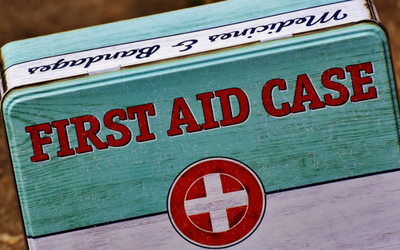
When an emergency strikes, many people know some basic first aid to assist family members, but are you prepared to help your furry friend if your pet has an emergency? April is Pet First Aid Awareness Month, so now is a good time to learn the skills you need to help your pet in case he has an emergency.
First and foremost, stay calm. Try to minimize your pet’s movement and contact your veterinary hospital for instructions. There are some steps you can take while waiting for further instructions from your veterinary office or while on route to the hospital. If you have another person available to help you – even better.
1) Insect stings: If you suspect that your pet has been stung by a bee there are steps you can take to minimize the reaction. Try to locate the stinger, and carefully scrape the stinger away using a credit card. Make a paste out of baking soda and water to soothe the area. To reduce swelling, apply ice or a cold towel to the area. If your pet begins to exhibit more serious symptoms such as severe swelling, hives, difficulty breathing, vomiting, or diarrhea, seek emergency veterinary care.
2) Bleeding due to deep cuts: Apply pressure using a bandage, piece of clothing, or towel. If the bleeding persists and is soaking through the bandage, don’t waste time – seek emergency veterinary care. Most wounds that are treated quickly can be sutured, but if you wait too long, surgery may be required.
3) Bites from cats, dogs, or other animals: Apply pressure to the wound. Seek veterinary care to prevent infection even if the wound seems minor or bleeding stops quickly.
4) Seizures: If your pet has a seizure do not restrain the animal. Pets can accidentally bite you while having, or right after the seizure because they may not know who you are. Keep your pet in a safe place during the seizure to protect him from injury, and keep him in a quiet, dark place after the seizure. Seek veterinary care immediately.
5) Eye injury:If your pet gets debris such as sand or grass in her eye, it may be possible to remove it by gently rinsing the eye with eyewash or saline solution. Seek veterinary care to prevent infection and assess if your pet’s cornea was scratched.
6) Heat stroke: NEVER leave your pet in a car on a hot day. If you suspect your pet has heat stroke, reduce your pet’s body temperature as quickly as possible using cool water and keep him wet during transport to the veterinarian. Do not use ice or ice water.
For more in-depth pet first aid training such as learning rescue breathing, CPR, and treatment for shock, consider taking a Pet First Aid course. Several organizations, including The Red Cross and St John’s Ambulance, offer such courses. If you don’t have access to taking a course, there are Android and iPhone apps that provide instructions for common first aid emergencies that can help you care for your pet until you can obtain veterinary care.
If your pet has been involved in an accident or emergency, take your pet to your veterinarian for an examination. Even if he appears to be fully recovered, it is important that your pet be thoroughly examined for injuries that may not be visible to you.